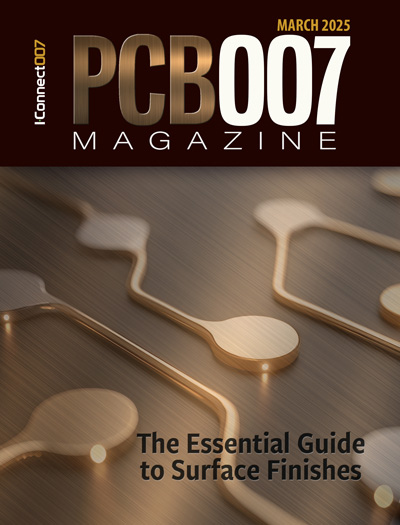-

- News
- Books
Featured Books
- pcb007 Magazine
Latest Issues
Current Issue
In Pursuit of Perfection: Defect Reduction
For bare PCB board fabrication, defect reduction is a critical aspect of a company's bottom line profitability. In this issue, we examine how imaging, etching, and plating processes can provide information and insight into reducing defects and increasing yields.

Voices of the Industry
We take the pulse of the PCB industry by sharing insights from leading fabricators and suppliers in this month's issue. We've gathered their thoughts on the new U.S. administration, spending, the war in Ukraine, and their most pressing needs. It’s an eye-opening and enlightening look behind the curtain.

The Essential Guide to Surface Finishes
We go back to basics this month with a recount of a little history, and look forward to addressing the many challenges that high density, high frequency, adhesion, SI, and corrosion concerns for harsh environments bring to the fore. We compare and contrast surface finishes by type and application, take a hard look at the many iterations of gold plating, and address palladium as a surface finish.
- Articles
- Columns
Search Console
- Links
- Media kit
||| MENU - pcb007 Magazine
The Application of Spherical Bend Testing to Predict Safe Working Manufacturing Process Strains
April 8, 2014 |Estimated reading time: 1 minute
Abstract
The increased temperatures associated with lead-free processes have produced significant challenges for PWB laminates. Newly developed laminates have different curing processes, are commonly filled with ceramic particles or micro-clays, and can have higher Tg values. These changes designed to reduce Z-axis expansion and improve the materials resistance to thermal excursions through primary attach and rework operations have also produced harder resin systems with reduced fracture toughness.
Celestica has undertaken an extensive “Spherical Bend Test” program to assess lead (Pb)-free compatible materials and area array packages. This work has confirmed “pad crater/pad lift” as the dominant failure mode in Pb-free materials in agreement with observations from multiple streams of field returned product. This work discusses the multiple phases of testing and the implications for mechanical reliability of Pb-free product. The initial phase was designed to confirm or refute the established relationship between strain rate and safe working strain in Pb-free materials. The second phase studied the effect of extended thermal excursions for an extensively used standard loss laminate material. The third phase was designed to directly compare standard loss laminate materials and has confirmed the impact of filled resin systems identified by other investigators.
This new work seems to confirm the relationship between board thickness and safe working strain established by in IPC/JEDEC-9704: “Printed Wiring Board Strain Gage Test Publication.” Data is only available for a limited number of package designs, but these selected packages are believed to generate conservative strain limits for manufacturing process guidelines. The design of the most recent test plan was intended to generate data that would allow investigators to generalize the effect of package compliance on the safe working strain of the assembly by correlation of test data from multiple packages to an existing simplified mechanical model.
Assembly processing, test methods and results will be documented in addition to discussion on resultant data, failure analysis, distribution parameters. The effectiveness and predictive range possible from the simplified model will also be discussed.Read the full article here.Editor's Note: This article originally appeared in the March 2014 issue of The PCB Magazine.


